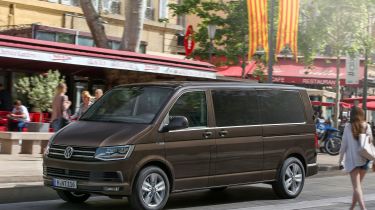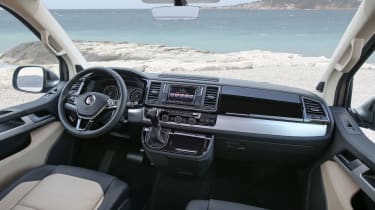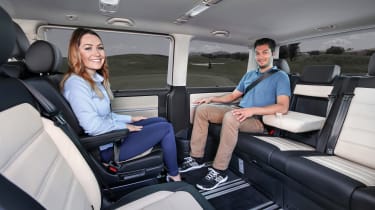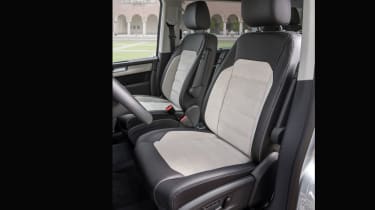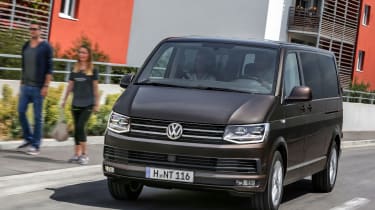New Volkswagen Caravelle 2015 review
Based on Volkswagen’s sixth generation Transporter, the Caravelle takes power and refinement to new levels

Volkswagen has delivered another class act with the new sixth-generation Transporter and the Caravelle people carrier version follows suit. The T6 Caravelle model continues with the old version’s strengths but adds even better levels of comfort, quality and refinement. Easy to drive and cleverly packaged, it proves transporting lots of people can be an enjoyable, even luxurious, pursuit.
Volkswagen’s Transporter van isn't just a commercial vehicle, the Caravelle, Shuttle and California that are based on it remain a popular option with buyers who have various people moving requirements. Indeed, older models have almost cult status among the surfing and outdoors communities, ensuring rock solid residual values for those who can afford the new price.
VW has sold more than 12 million Transporters and Caravelles over the last 65 years, and 2 million of them were the T5 model that this new T6 version replaces. With Caravelle prices starting at just over £30,000, the big VW is not cheap. However more powerful Euro 6 diesel engines, the option of a seven-speed DSG transmission and even four-wheel-drive if required, ensure that there are customers ready to dig deep.
Available in short and long wheelbases, the Caravelle offers a wide range of seating and load-carrying configurations. Up to three rows of seats are available in the back of the longer Shuttle van, allowing comfortable travel for up to nine people plus luggage. Seats don't fold flat but can be removed without tools to deliver a versatile transport solution for businesses and families.
Used - available now

2020 Vauxhall
Grandland X
48,234 milesManualPetrol1.2L
Cash £9,981
2023 Peugeot
208
17,568 milesAutomaticPetrol1.2L
Cash £15,874
2020 Peugeot
208
13,135 milesManualPetrol1.2L
Cash £12,330
2016 Toyota
GT86
45,202 milesAutomaticPetrol2.0L
Cash £15,313UK customers can choose from SE, Executive and Business trim levels and VW has confirmed that it will bring the retro two-tone special edition Caravelle to the UK. As well as the bi-colour paintjob, which is available in four combinations, the colour is extended to the dash and the vehicles have special white 18” wheels that draw heavily from Volkswagen’s microbus back catalogue.
Depending on specification the Caravelle has one or two rotatable seats in the second row, allowing two passengers to turn and face the rear bench occupants. Each individual perch has ISOFIX retainers for child seats. All of the seats behind the driver can be moved or removed, to offer up to 3.5m3 of load volume in the short wheelbase models and up to 4.4m3 in the long wheelbase. Even with all seats in place though, the Caravelle offers generous load space for luggage behind the last row of seating.
The seats are comfortable whichever row you select too and there is air conditioning to each row through roof vents in Executive trim and above. Access to all seats is easy, thanks to power-latching sliding side doors on both sides.
The shorter of the two vehicles is 4,892mm long and 1,970mm tall, so is relatively easy to thread through traffic. The longer model takes up 5,292mm of roadspace and has a roof height of 1,990mm, so check restrictions before heading to a multi-story car park.
Both Caravelle models are easy to drive though, with their high seating position delivering a panoramic view of the road ahead. They have light yet direct steering and the suspension manages to cope with the size of the vehicles well.
All Caravelle models now come with Euro 6 compliant 2.0-litre TDI engines, delivering 101bhp, 148bhp and in bi-turbo form, a hefty 201bhp. They are a straight replacement for the previous 101bhp, 138bhp and 178bhp and the two more powerful engines get a choice of six-speed manual gearbox or seven-speed DSG automated transmission.
UK buyers are split 53 per cent to 47 per cent in terms of the 178bhp and 138bhp engines at present. The majority of 178bhp customers are expected to make the move up to the 201bhp motor when they renew. However cost-savvy business users will probably take the opportunity to drop to the more frugal and lower cost 148bhp engine, which provides more than enough power.
Around 74 per cent of UK buyers go for the DSG transmission with the rest taking the manual. In either case, drive is to the front wheels, although VW’s 4Motion all-wheel drive is available as an option on the more powerful models.
We tried the 148bhp engine with a six-speed manual gearbox and it delivered excellent acceleration and easy cruising on the motorway. The 201bhp engine with the DSG box produces luxury level travel, offering whisper-quiet progress and enough power to cope with occupants in every seat plus luggage.
The Euro 6 engines have Selective Catalytic Reduction (SCR) with AdBlue exhaust additive. The AdBlue filler is in the same flap as the vehicle’s diesel tank neck and the adoption of the 13-litre AdBlue tank has seen the fuel tank drop in size from 80 litres to 70 litres. However given the promised improvement in fuel consumption, of at least 15 per cent across the range, this shouldn’t result in additional trips to the petrol station.
Final fuel figures have yet to be released, but the 148bhp engine with a manual gearbox now delivers 155-157g/km of CO2, depending on model, or 149-151g/km with DSG. The 201bhp engine produces 165-167g/km with the manual and 160g/km with DSG.
